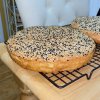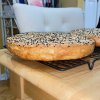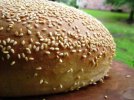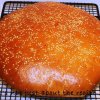So Ill start by saying Im no baker and what little I know is self taught. My muffuletta bread is good but not where I want it to be. The crust is kinda crackly/crunchy and authentic muffuletta bread crust is more soft like sandwich bread. The crumb of my loaves are fine because they are dense enough to stand up to the oil/olive salad. I will attache my recipe and some pics of mine and pics of New Orleans style muffuletta loaves below. And here are a few questions if anyone can help.
1. How do I get a softer crust?
2. How do I get that beautiful golden brown color? I brush mine with egg wash before baking.
3. I bake mine in a 9" pan. How do the get those smooth rounded edges? I assume the dough is flattened out and left to rise, then its baked on a stone with no pan.
4. How do I get more lift in the center of the dough (like a dome shape)? Mine tend to be kinda flat.
RecipeMuffuletta Bread
12 oz/355g warm water (between 105°-110°)
2 Tbsp/18g shortening (or olive oil)
1.5 tsp/5.25g table salt
2 tsp/7g instant yeast
1 Tbsp/12.5g sugar
3.5 cups/518g bread flour
Add yeast, sugar and water in stand mixer bowl and let bloom for 10 minutes to make sure yeast is alive. Add oil. Add salt to flour and then incorporate into bowl attached with dough hook on low speed. Continue to knead until dough comes together nicely. At this point I split the dough into two even portions and then roll and tuck until smooth balls are formed. Place in two lightly oiled bowls and spritz a little oil on top of dough, cover with cling wrap and let proof in the oven with oven light on for 1.5 hours. After proofing, punch down doughs and place in two oiled 9” round pans. If dough feels really elastic from overhanding, let it rest in the pans for 10 minutes covered for the gluten to relax. spread evenly into the pans, cover and let rise a second time for 45 minutes in the oven. After the second rise, remove from oven and preheat to 400°. While preheating, mix one whole egg with a tad of cold water, whisk and then gently paint the tops of the loaves. Sprinkle with sesame seeds and bake for 18-40 minutes. The length of time depends on the amount of egg wash. It can get dark in as quick as 18-20 minutes, buy may take between 18-40 minutes. Keep an eye on it. Let cool on racks (I do it in front of a fan for quicker cooling), slice and load with muffuletta goodness. The first 2 pics are mine and the second two are bakery muffuletta bread.
1. How do I get a softer crust?
2. How do I get that beautiful golden brown color? I brush mine with egg wash before baking.
3. I bake mine in a 9" pan. How do the get those smooth rounded edges? I assume the dough is flattened out and left to rise, then its baked on a stone with no pan.
4. How do I get more lift in the center of the dough (like a dome shape)? Mine tend to be kinda flat.
RecipeMuffuletta Bread
12 oz/355g warm water (between 105°-110°)
2 Tbsp/18g shortening (or olive oil)
1.5 tsp/5.25g table salt
2 tsp/7g instant yeast
1 Tbsp/12.5g sugar
3.5 cups/518g bread flour
Add yeast, sugar and water in stand mixer bowl and let bloom for 10 minutes to make sure yeast is alive. Add oil. Add salt to flour and then incorporate into bowl attached with dough hook on low speed. Continue to knead until dough comes together nicely. At this point I split the dough into two even portions and then roll and tuck until smooth balls are formed. Place in two lightly oiled bowls and spritz a little oil on top of dough, cover with cling wrap and let proof in the oven with oven light on for 1.5 hours. After proofing, punch down doughs and place in two oiled 9” round pans. If dough feels really elastic from overhanding, let it rest in the pans for 10 minutes covered for the gluten to relax. spread evenly into the pans, cover and let rise a second time for 45 minutes in the oven. After the second rise, remove from oven and preheat to 400°. While preheating, mix one whole egg with a tad of cold water, whisk and then gently paint the tops of the loaves. Sprinkle with sesame seeds and bake for 18-40 minutes. The length of time depends on the amount of egg wash. It can get dark in as quick as 18-20 minutes, buy may take between 18-40 minutes. Keep an eye on it. Let cool on racks (I do it in front of a fan for quicker cooling), slice and load with muffuletta goodness. The first 2 pics are mine and the second two are bakery muffuletta bread.




